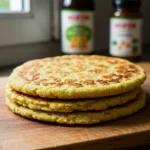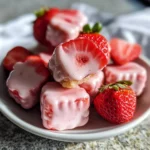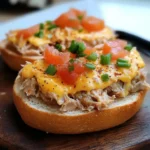Introduction
In the world of culinary delights, the chickpea flour flatbread stands out as a versatile, nutritious, and gluten-free option that is easy to make and perfect for a variety of occasions. Whether you’re looking to create a quick snack, a healthy meal, or a delightful side dish, this flatbread recipe is sure to meet your needs. Chickpea flour, also known as gram flour or besan, is rich in protein, fiber, and essential nutrients, making it a popular choice among health enthusiasts and those with dietary restrictions. The flour is naturally gluten-free, making it an excellent alternative for anyone avoiding gluten, while also providing a hearty, nutty flavor that pairs beautifully with a wide range of toppings or fillings.
This flatbread is also highly adaptable, allowing you to experiment with different seasonings, herbs, and spices. You can add garlic, cumin, turmeric, or even fresh cilantro to create unique variations that suit your taste. Its easy preparation and minimal cooking time make it an ideal option for busy days, whether you’re serving it alongside a vegetable curry, enjoying it with a dip, or even using it as a wrap for your favorite fillings.
In this article, we will explore how you can easily whip up this delicious flatbread with a handful of simple ingredients. Whether you’re new to chickpea flour or already a fan, you’ll find that this recipe is not only quick and simple but also a delicious way to incorporate more plant-based, nutrient-rich ingredients into your diet.
Ingredients
To create your own chickpea flour flatbread, gather the following ingredients:
- 1 cup chickpea flour
- 1 cup water
- 1/2 tsp salt
- 1 tbsp olive oil
- Optional: spices like cumin, garlic powder, or herbs
These ingredients combine to create a flavorful and nutritious flatbread that’s a great addition to any meal.
Instructions
Creating chickpea flour flatbread is a straightforward process. Follow these steps to ensure perfect results every time:
- Mix the Dry Ingredients: In a bowl, combine the chickpea flour, salt, and any optional spices you prefer. This is where you can customize the flavor profile to suit your taste preferences.
- Add Water Gradually: Gradually add the water to the dry ingredients, stirring continuously until the mixture is smooth and free of lumps. The batter should have a pourable consistency.
- Let the Batter Rest: Allow the batter to rest for about 10 minutes. This resting period helps the flour absorb the water, resulting in a better texture for your flatbread.
- Heat the Pan: In a non-stick pan, heat the olive oil over medium heat. Ensure the oil is evenly distributed across the pan for even cooking.
- Cook the Flatbread: Pour a ladleful of batter into the center of the hot pan. Use the back of the ladle to spread the batter into a thin, even circle. Cook for 3-4 minutes, or until the edges begin to lift from the pan.
- Flip and Cook the Other Side: Carefully flip the flatbread using a spatula and cook for an additional 2-3 minutes, or until golden brown.
- Repeat the Process: Repeat steps 5 and 6 with the remaining batter, adding more oil to the pan if necessary.
Nutrition Facts
Each chickpea flour flatbread offers a host of nutritional benefits. Here are the nutrition facts per flatbread:
- Calories: 120
- Protein: 6g
- Carbs: 18g
- Fat: 4g
- Fiber: 5g
This nutritional profile makes chickpea flour flatbread a balanced choice, providing energy, protein, and fiber, while remaining low in calories.
How to Serve Chickpea Flour Flatbread
Chickpea flour flatbread is not only a delicious staple but also an incredibly versatile addition to various meals. Its nutty flavor and satisfying texture make it an ideal companion for an array of ingredients and dishes. Here are some comprehensive ways to serve chickpea flour flatbread that will enhance your dining experience:
1. As a Wrap
One of the most popular uses for chickpea flour flatbread is as a wrap. Its pliability and strength allow it to hold a multitude of fillings without tearing. Here are some ideas to create a delightful wrap:
- Vegetable Medley: Fill your flatbread with a mix of roasted or sautéed seasonal vegetables such as bell peppers, zucchini, and eggplant. Add a smear of hummus or tahini for creaminess and a sprinkle of fresh herbs like parsley or cilantro for brightness.
- Protein-Packed Filling: For a heartier option, use grilled chicken or turkey slices, along with leafy greens like spinach or arugula. A drizzle of your favorite dressing or sauce can elevate the flavors even further. Consider adding feta cheese or avocado for extra richness.
- Plant-Based Alternatives: For a vegan wrap, you can fill the flatbread with falafel, shredded carrots, cucumber slices, and a vegan tzatziki made from cashew yogurt. This combination will provide a satisfying and nutritious meal.
2. With Dips
Chickpea flour flatbread pairs wonderfully with various dips, making it an excellent choice for appetizers or snack platters. Here are some dip options to consider:
- Tzatziki: This refreshing Greek dip made from yogurt, cucumber, garlic, and dill complements the earthy flavors of the flatbread. Serve it chilled alongside warm flatbread for a delightful contrast.
- Baba Ghanoush: This smoky eggplant dip is a perfect match for chickpea flatbread. Its creamy texture and rich flavor profile enhance the flatbread’s nutty taste, making for a satisfying combination.
- Spicy Harissa Sauce: If you enjoy a bit of heat, serve your flatbread with a dollop of harissa, a North African chili paste. Mix it with olive oil or yogurt for a creamy, spicy dip that will tantalize your taste buds.
- Guacamole: For a twist, consider pairing your flatbread with a zesty guacamole. The creaminess of the avocado paired with lime juice and cilantro creates a refreshing dip that contrasts beautifully with the flatbread.
3. As a Side
Chickpea flour flatbread is an excellent side dish that can elevate any meal. Here are some ways to incorporate it:
- With Soups: Serve the flatbread alongside hearty soups like lentil soup, minestrone, or tomato bisque. Tear off pieces of the flatbread to soak up the rich, flavorful broth, adding a satisfying texture to your soup experience.
- Accompanying Stews: Pair the flatbread with robust stews, such as Moroccan tagine or Indian dal. The flatbread serves as a perfect vehicle for scooping up the stew, allowing you to enjoy every last bite.
- Salad Companion: Use the flatbread as a side to fresh salads, such as a traditional Greek salad or a quinoa salad with roasted vegetables. It adds a delightful crunch and heartiness that complements the lightness of the salad.
4. For Breakfast
Chickpea flour flatbread can also serve as a nutritious foundation for breakfast dishes. Consider these ideas to kickstart your day:
- Avocado Toast: Spread mashed avocado on the flatbread and top with sliced radishes, cherry tomatoes, and a sprinkle of sea salt. For added protein, include a poached or fried egg on top.
- Smoked Salmon Delight: Layer smoked salmon on the flatbread with cream cheese, capers, and thinly sliced red onions. This combination offers a gourmet breakfast option that’s both filling and flavorful.
- Breakfast Burrito: Fill the flatbread with scrambled eggs, sautéed spinach, and shredded cheese to create a breakfast burrito. Roll it up and enjoy it on the go for a nutritious start to your day.
- Sweet Options: For a sweeter breakfast, spread nut butter on the flatbread and top it with sliced bananas or berries, drizzled with honey or maple syrup. This offers a delightful contrast of flavors and textures to kick off your morning.
By exploring these various serving suggestions, you can fully appreciate the versatility of chickpea flour flatbread. Whether as a wrap, a side dish, or a breakfast option, this flatbread can enhance your meals with its unique flavor and satisfying texture. Experiment with different fillings, dips, and toppings to find your favorite combinations and make every meal an exciting culinary adventure.
Additional Tips for Perfecting Chickpea Flour Flatbread
Creating the perfect chickpea flour flatbread requires attention to detail and a willingness to experiment. Here are some expanded tips to help you achieve delicious, fluffy flatbreads that can elevate your meals.
Choose Quality Ingredients
The foundation of any great dish lies in the quality of its ingredients. When selecting chickpea flour, consider sourcing from reputable brands that offer organic or stone-ground options, as these tend to retain more nutrients and flavor. Freshly ground chickpea flour will have a nuttier taste and finer texture compared to stale or mass-produced varieties. Additionally, the spices you use can dramatically affect the overall flavor. Opt for whole spices that you can grind yourself for maximum freshness or select high-quality pre-ground spices. Fresh herbs, such as cilantro or parsley, can also add a burst of flavor and vibrant color to your flatbread.
Adjust Consistency
Achieving the right batter consistency is crucial for the texture of your flatbread. If your batter is too thick, it may lead to dense flatbreads that are difficult to cook evenly. Start by adding water gradually, mixing thoroughly, until you reach a pourable yet thick consistency. Conversely, if your batter is too thin and runny, your flatbreads may spread too much in the pan, resulting in uneven cooking. In this case, add chickpea flour in small increments, ensuring that you mix well after each addition. The ideal consistency should resemble that of pancake batter — pourable but thick enough to hold its shape when spread in the pan.
Experiment with Flavors
One of the joys of cooking is the ability to customize your dishes. Chickpea flour flatbread serves as a versatile canvas for various flavors. Consider incorporating spices such as turmeric for an earthy, golden hue, or cumin for a warm, aromatic profile. You can also add a pinch of red chili powder or smoked paprika for a hint of heat and smokiness. Fresh herbs like dill or basil can introduce fresh, vibrant notes that brighten the overall flavor. Don’t shy away from adding finely chopped vegetables such as spinach, onions, or bell peppers to the batter for added nutrition and texture. Each variation can transform your flatbread into a unique culinary experience.
Storage
Proper storage is essential for keeping your chickpea flour flatbread fresh and retaining its taste and texture. If you have leftover flatbread, allow it to cool completely before placing it in an airtight container. This prevents moisture buildup, which can lead to sogginess. When stored correctly in the refrigerator, your flatbread can last for up to three days. To reheat, place the flatbread in a dry pan over medium heat. This method will help restore its original crispness and warmth without making it rubbery. Alternatively, you can wrap the flatbread in foil and warm it in the oven for a few minutes. For longer storage, consider freezing the flatbread. Stack pieces with parchment paper in between to prevent sticking, then place them in a freezer-safe bag or container. To enjoy, simply thaw and reheat as described.
By following these additional tips, you can ensure that your chickpea flour flatbread turns out perfectly every time, providing a delicious and nutritious addition to your meals. Whether you enjoy them on their own, use them as wraps, or serve them alongside dips and curries, these flatbreads are sure to impress!
FAQs
1. Can I make this recipe vegan and gluten-free?
Yes! This chickpea flour flatbread is naturally vegan and gluten-free, making it suitable for those following these dietary lifestyles.
2. Can I freeze the flatbread for later use?
Absolutely. Allow the flatbread to cool completely, then stack them with parchment paper in between each piece. Store in a freezer-safe bag for up to 2 months. Reheat in a pan or oven before serving.
3. What can I substitute for olive oil?
You can use any neutral-tasting oil such as avocado oil or canola oil. Coconut oil can also be used for a slightly different flavor profile.
4. Is chickpea flour the same as regular flour?
No, chickpea flour is made from ground chickpeas and is gluten-free, whereas regular flour is typically made from wheat and contains gluten.
5. Can I make the batter ahead of time?
Yes, you can prepare the batter a few hours ahead and store it in the refrigerator. Stir well before using, as it may thicken over time.
Conclusion
Chickpea flour flatbread is a simple, healthy, and delicious option that fits seamlessly into a variety of meals. With its high protein and fiber content, it offers a satisfying and nutritious alternative to traditional bread. Whether you’re cooking for yourself or entertaining guests, this flatbread is sure to impress with its flavor and versatility. So, gather your ingredients and start creating this delightful flatbread today!
Print
Chickpea Flour Flatbread Recipe
Ingredients
-
- 1 cup chickpea flour
-
- 1 cup water
-
- 1/2 tsp salt
-
- 1 tbsp olive oil
-
- Optional: spices like cumin, garlic powder, or herbs
Instructions
-
- Mix the Dry Ingredients: In a bowl, combine the chickpea flour, salt, and any optional spices you prefer. This is where you can customize the flavor profile to suit your taste preferences.
-
- Add Water Gradually: Gradually add the water to the dry ingredients, stirring continuously until the mixture is smooth and free of lumps. The batter should have a pourable consistency.
-
- Let the Batter Rest: Allow the batter to rest for about 10 minutes. This resting period helps the flour absorb the water, resulting in a better texture for your flatbread.
-
- Heat the Pan: In a non-stick pan, heat the olive oil over medium heat. Ensure the oil is evenly distributed across the pan for even cooking.
-
- Cook the Flatbread: Pour a ladleful of batter into the center of the hot pan. Use the back of the ladle to spread the batter into a thin, even circle. Cook for 3-4 minutes, or until the edges begin to lift from the pan.
-
- Flip and Cook the Other Side: Carefully flip the flatbread using a spatula and cook for an additional 2-3 minutes, or until golden brown.
-
- Repeat the Process: Repeat steps 5 and 6 with the remaining batter, adding more oil to the pan if necessary.
Nutrition
- Serving Size: One Normal Portion
- Calories: 120
- Fat: 4g
- Carbohydrates: 18g
- Fiber: 5g
- Protein: 6g






